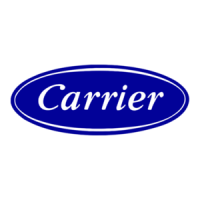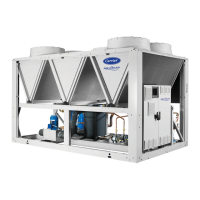6
Ensure regularly that the vibration levels remain accept-
able and close to those at the initial unit start-up.
Before opening a refrigerant circuit, purge and consult the
pressure gauges.
Change the refrigerant after an equipment failure, following
a procedure such as the one described in NF E29-795 or
carry out a refrigerant analysis in a specialist laboratory.
If the refrigerant circuit remains open for longer than a day
after an intervention (such as a component replacement),
the openings must be plugged and the circuit must be
charged with nitrogen (inertia principle). The objective is to
prevent penetration of atmospheric humidity and the result-
ing corrosion on the internal walls and on non-protected
steel surfaces.
All installation parts must be maintained by the personnel
in charge, in order to avoid deterioration and injury. Faults
and leaks must be repaired immediately. The authorised
technician must have the responsibility to repair the fault
immediately. After each repair of the unit, check the opera-
tion of the protection devices and create a report of the
parameter operation at 100%.
Comply with the regulations and recommendations in unit
and HVAC installation safety standards, such as: EN 378,
ISO 5149, etc.
Never use air or a gas containing oxygen during leak tests to
purge lines or to pressurise a machine. Pressurised air
mixtures or gases containing oxygen can be the cause of an
explosion. Oxygen reacts violently with oil and grease.
Only use dry nitrogen for leak tests, possibly with an
appropriate tracer gas.
If the recommendations above are not observed, this can
have serious or even fatal consequences and damage the
installation.
Never exceed the specified maximum operating pressures.
Verify the allowable maximum high- and low-side test
pressures by checking the instructions in this manual and
the pressures given on the unit name plate.
Do not unweld or flamecut the refrigerant lines or any
refrigerant circuit component until all refrigerant (liquid
and vapour) as well as the oil have been removed from
chiller. Traces of vapour should be displaced with dry
nitrogen. Refrigerant in contact with an open flame
produces toxic gases.
The necessary protection equipment must be available,
and appropriate fire extinguishers for the system and the
refrigerant type used must be within easy reach.
Do not siphon refrigerant.
Avoid spilling liquid refrigerant on skin or splashing it into
the eyes. Use safety goggles and safety gloves. Wash any
spills from the skin with soap and water. If liquid
refrigerant enters the eyes, immediately and abundantly
flush the eyes with water and consult a doctor. Never apply
an open flame or live steam to a refrigerant container.
Dangerous overpressure can result.
During refrigerant removal and storage operations follow
applicable regulations. These regulations, permitting condi-
tioning and recovery of halogenated hydrocarbons under
optimum quality conditions for the products and optimum
safety conditions for people, property and the environment
are described in standard NF E29-795.
Refer to the certified dimensional drawings for the units.
It is dangerous and illegal to re-use disposable (non-return-
able) cylinders or attempt to refill them. When cylinders
are empty, evacuate the remaining gas pressure, and move
them to a designated place for recovery. Do not incinerate.
Do not attempt to remove refrigerant circuit components
or fittings, while the machine is under pressure or while it
is running. Be sure pressure is at 0 kPa and that the unit
has been shut-down and de-energised before removing
components or opening a circuit.
Do not attempt to repair or recondition any safety devices
when corrosion or build-up of foreign material (rust, dirt,
scale, etc.) is found within the valve body or mechanism.
If necessary, replace the device. Do not install safety
valves in series or backwards.
ATTENTION: No part of the unit must be used as a
walkway, rack or support. Periodically check and repair
or if necessary replace any component or piping that
shows signs of damage.
Do not step on refrigerant lines. The lines can break under
the weight and release refrigerant, causing personal injury.
Do not climb on a machine. Use a platform, or staging to
work at higher levels.
Use mechanical lifting equipment (crane, hoist, winch, etc.)
to lift or move heavy components. For lighter components,
use lifting equipment when there is a risk of slipping or
losing your balance.
Use only original replacement parts for any repair or compo-
nent replacement. Consult the list of replacement parts
that corresponds to the specification of the original equip-
ment.
Do not drain water circuits containing industrial brines,
without informing the technical service department at the
installation site or a competent body first.
Close the entering and leaving water shutoff valves and
purge the unit hydronic circuit, before working on the
components installed on the circuit (screen filter, pump,
water flow switch, etc.).

